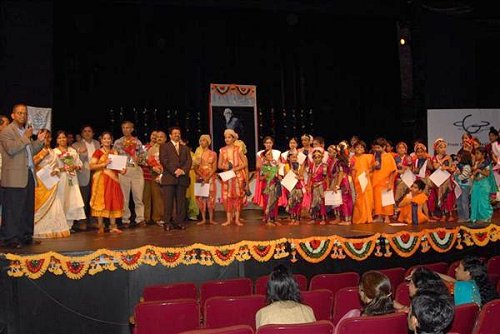 |
 |
Nritya Madhavi
and Kuchipudi Suma Maala: A celebration of dance
October 7,
2008
 The program was organized in 3 well-defined sessions. The first half
primarily focused on 6 individual choreographies of Divya Yeluri and others.
Tulasidas' Rama Bhajan was the last number in this section. Anitra Das and Sailaja Medicherla, with their in-depth expression and involvement took us all to Treta Yuga, the age of Lord Rama. Sailaja's depiction of certain episodes such as Sita Swayamvaram and Ahalya Sapavimochana portrayed a living, breathing entity. The second half of the program comprised the ever-popular ballet 'Sri Krishna Parijatham,' one of the most exquisite dance dramas of legendary Kuchipudi guru Dr. Vempati Chinna Satyam. Kuchipudi dance dramas enjoy a unique standing in South Indian classical dances. The 2-hour production revolves around 4 main characters, Sage Narada depicted by the young and ebullient Natasha Antony, Lord Krishna by the mischievous-looking Supreeta Goteti, Rukmini by the poignant Rashmi Srinivas and the bewitching Satyabhama, by Divya Yeluri herself. The dance opens with Sage Narada, who is popularly known as 'Kalahabhojanudu,' meaning one whose appetite is only satiated after conniving a sumptuous quarrel, pondering over a palatable plot to instigate a quarrel between Lord Krishna and his favourite consorts, Rukmini and Satyabhama. He then comes up with a wonderful idea wherein the celestial flower Parijatham becomes the stimulant for the quarrel. The role of Narada, which bears a hint of sarcasm and humor, was explicitly conveyed through the young and hearty Natasha Anthony. The second scene marks the entry of Rukmini, who later accompanied by her beloved Krishna performs the well known tarangam "Neelamegha Sareera" on a brass plate. In the same act, Narada plants the seed of jealousy and rivalry by persuading Krishna to adorn the beautiful Parijatha flower in Rukmini's hair, thereby instigating the wrath of Satyabhama. Both Rashmi and Supreeta excelled in the characters of Rukmini and Krishna. The third scene is the heart of the production and comprises of episodes such as the Bhama Pravesam - entry of Satyabhama with the ever so popular "Bhamane...Satya Bhamane," the much acclaimed "Lekha" which is Satyabhama's love letter to her Lord, wherein she pours out her anguish of separation, and then the "Satyabhama Sapatham" where Satyabhama, (after Narada informs her that Rukmini is the beneficiary of the celestial flower and Krishna's love) is upset by the whole episode and makes a vow to make Krishna fall at her feet. Satyabhama's role in this ballet encapsulates the Nava Rasas in totality and the character of Satyabhama was portrayed by Divya with ease and dexterity. The tussle between Rukmini, Satyabhama and Krishna as both beloveds of Krishna try to establish who among them is the most sought-after, etched a lasting impression on the audience. The piece concludes with Satyabhama being de-robed of her pride and vanity and realizing that devotion (bhakti) alone is the means to attaining oneness with the Lord.
Prakriti, a young girl of the untouchable caste, or the Chandalis, is shunned by those around her because of society's terrible practice of oppressing a sector of its own people due to perceived inferiority. A wandering Buddhist monk asks Prakriti (or Chandalika), for some water. Chandalika initially refuses, stating that society forbids a higher individual such as the monk to interact with an untouchable. The monk Ananda, persuades Chandalika to give him water and sermonizes to her that all human beings are one in the eyes of God. Ananda then continues on his way, but Chandalika has fallen in love with him. She begs her mother to use her magical powers to bring this marvelous being to her. When he returns by the power of magic, shamed and degraded, Chandalika realizes that she has done him great harm and asks for forgiveness. Divya played the protagonist Chandalika and was supported by 30 of her disciples in various roles such as Buddhist monks, flower girls, bangle sellers, evil spirits, King’s courtiers and "anusasanikas." Divya's soul stirring portrayal of Chandalika reiterates once again her passion for dance and commitment to only the best. She was ably supported by Bala Unnava as Maya, Chandalika’s mother and Ramesh Rachapudi as the parched Buddhist monk Ananda, the other main characters in the ballet. New Jersey Assemblyman Upendra Chivukula graced the occasion as Chief Guest and honored the artistes and also the organizers and gurus of various national organizations such as TANA, TFAS, ATA and Indian music and dance institutions in the tri-state. He lauded the yeoman services being rendered by all these organizations and institutions in upholding the Indian cultural veracity in North America. Mahesh Saladi, Managing Director and CFO of First Atlantic Capital, and Damu Gedela, President of Telugu Fine Arts Society (TFAS), attended the function as Guests of Honor and blessed the school and artistes. Kudos to Nritya Madhavi and Divya Yeluri for orchestrating such a mega event and delivering it with such professional and artistic precision. The students of Nritya Madhavi unanimously presented a beautiful memento to their guru in recognition of her commitment and devotion put into shaping each one of them and imbibing in them a passion for Indian art and dance. Corporate sponsorship
for the function was extended by Global Tek Inc, a leading IT solutions
provider in South Plainfield, New Jersey.
Padma
Raju is a freelance journalist from LA contributing to art and culture
sections of Indian newspapers and journals.
|